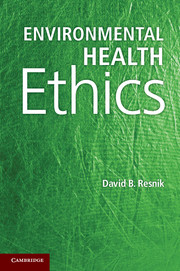Book contents
- Frontmatter
- Contents
- Figures and Tables
- Acknowledgments
- Abbreviations
- 1 Introduction
- 2 An Overview of Environmental Health
- 3 Ethical Theory
- 4 Toward an Environmental Health Ethics
- 5 Pest Control
- 6 Genetic Engineering, Food, and Nutrition
- 7 Pollution and Waste
- 8 The Built Environment
- 9 Climate Change, Energy, and Population
- 10 Justice and Environmental Health
- 11 Environmental health Research Involving Human Participants
- 12 Conclusion
- References
- Index
10 - Justice and Environmental Health
Published online by Cambridge University Press: 05 July 2012
- Frontmatter
- Contents
- Figures and Tables
- Acknowledgments
- Abbreviations
- 1 Introduction
- 2 An Overview of Environmental Health
- 3 Ethical Theory
- 4 Toward an Environmental Health Ethics
- 5 Pest Control
- 6 Genetic Engineering, Food, and Nutrition
- 7 Pollution and Waste
- 8 The Built Environment
- 9 Climate Change, Energy, and Population
- 10 Justice and Environmental Health
- 11 Environmental health Research Involving Human Participants
- 12 Conclusion
- References
- Index
Summary
As we have seen throughout this book, justice is an important concern in environmental health because health risks related to the environment are often distributed unequally. Risks are distributed unequally because people face different types of health hazards depending on where they live, work, attend school, shop, travel, or recreate (Shrader-Frechette 2002, 2007a). Though we have touched briefly on some justice concerns in earlier chapters, in this chapter we explore ethical and policy issues related to the distribution of health risks in the environment in greater depth.
HEALTH INEQUALITIES AND THE ENVIRONMENT
To better understand the relationship between the environment and justice, it will be useful to reflect upon how different aspects of the environment can contribute to health inequalities (often referred to as health disparities). A large body of literature has documented demographic differences in mortality, morbidity, and disease burden among people living in the same nation as well as differences among nations (Barr 2008). Life expectancy in the United States is higher for whites than for blacks (U.S. Census Bureau 2010b). Among these two groups, white females have the highest life expectancy (80.8 years), followed by black females (76.8 years), white males (75.9 years), and black males (70.0 years) (Xu et al. 2010). Latinos have a higher life expectancy than whites. Latino women have a life expectancy of 83.1 years, and Latino males have a life expectancy of 77.9 years (Arias 2010). Infant mortality rates vary considerably by race and ethnicity in the United States. Blacks have an infant mortality rate of 13.6 deaths per 1,000 live births, followed by Puerto Ricans (8.3), Native Americans (8.1), whites (5.8), Mexicans (5.5), Asians (4.9), and Cubans (4.4) (MacDorman and Mathews 2008).
- Type
- Chapter
- Information
- Environmental Health Ethics , pp. 202 - 221Publisher: Cambridge University PressPrint publication year: 2012

